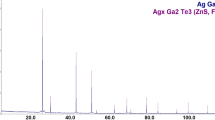Abstract
The potentialvs pH diagram or Pourbaix diagram for the Ag-S-H2O system has been calculated from available thermodynamic data for 25‡ and 100 ‡C. The diagrams developed show the dependence of the electrochemical equilibria on the concentration of [Ag+] and the total dissolved sulfur. The appearance of the diagram is significantly altered when the solubility product for Ag2SO4 is exceeded. Various electrochemical experiments have been performed in acid solutions using Ag2S electrodes for comparison between anticipated reactions from the diagrams and experimental results. The rest potential in acid solution shows a dependence of 0.055 V/decade change in [Ag+] concentration. Mass balances performed at constant cathodic potentials suggest the reaction Ag2S + 2H+ +2e - = 2Ag + H2S. Hydrogen evolution is a competing reaction which becomes less important as the surface becomes more completely covered with elemental silver due to the large hydrogen overvoltage on Ag. Similar anodic experiments have shown that part of the dissolution can be attributed to Ag2S = 2Ag+ + S +2e - with some of the mineral forming SO =4 or HSO -4 directly. The sulfur which forms is not completely protective, since the current observed during anodic potential sweeps is stirring dependent. This is consistent with the formation of Ag2SO4 on the electrode surface, which was confirmed by SEM and X-ray diffraction techniques.
Similar content being viewed by others
References
M. Pourbaix:Atlas of Electrochemical Equilibria in Aqueous Solutions, National Association of Corrosion Engineers, Houston, TX, 1974, pp. 19–89, 313-20, and 115-17.
R. M. Garrels and C. L. Christ:Solutions, Minerals and Equilibria, Freeman, Cooper & Co., San Francisco, CA, 1965, pp. 172–263, 394-400, and 422-24.
E. Peters: inTrends in Electrochemistry, J. O’M. Bockris, D. Rand, and B. Welch, eds., Plenum Press, New York, NY, 1977, pp. 267–90.
D. D. MacDonald and B. C. Syrett:Corrosion, 1979, vol. 35, pp. 471–75.
J. D. Miller and H. Q. Portillo:Dev. Miner. Process., 1981, vol. 2, pp. 851–901.
T. T. Chen, J. E. Dutrizac, D. R. Owens, and J. H. Laflamme:Canadian Mineralogist, 1980, vol. 18, pp. 173–80.
G. A. Khan, P. M. Solozhenkin, and G. I. Barlova:Izv. Vyssh. Ucheb. Zared., Tsvet. Met., 1970, vol. 13, pp.11–14.
V. A. Tyagai, N. A. Petrova, and V. N. Bondarenko:Izv. Akad. Nauk. SSSR, Neorg. Mater., 1969, vol. 5, pp. 864–67.
J. Horvath and M. Novak:Corrosion Science, 1964, vol. 4, pp. 159–78.
J. Horvath and L. Hackl:Corrosion Science, 1965, vol. 5, pp. 1525–38.
M. Hansen and K. Anderko:Constitution of Binary Alloys, 2nd ed., McGraw-Hill, New York, NY, 1958, pp. 46–48.
C. M. Criss and J. W. Cobble:Am. Chem. Soc. Journal, 1964, vol. 86, pp. 5385–5893.
H. C. Helgeson:Am. J. of Science, 1969, vol. 265, pp. 729–804.
K. K. Kelly: U. S. Bureau of Mines, Bulletin 584, 1960, pp. 79,137, and 181.
I. Barin and O. Knacke:Thermochemical Properties of Inorganic Substances, Springer-Verlag, 1973, pp. 1–7 and theSupplement, by I. Barin, O. Knacke, and O. Kubaschewski, 1977, pp. 1-3.
Gmelins Handbuch der Anorganischen Chemie, 8th ed., Gmelin Institute, Verlag Chemie, Weinberg, 1971, vol. 61, Bl.
M. H. Lietzke and R. W. Stoughton:J. Phys. Chem., 1961, vol. 65, pp. 2247–49.
J. E. Dutrizac, R. J. C. MacDonald, and R. E. Lamarche:J. Chem. Eng. Data, 1975, vol. 20, pp. 55–58.
P. B. Munoz, J. D. Miller, and M. E. Wadsworth:Metall. Trans. B, 1979, vol. 10B, pp. 149–58.
J. E. Dutrizac and R. J. C. MacDonald:Metall. Trans. B, 1978, vol. 9B, pp. 543–51.
G. W. Warren, M. E. Wadsworth, and S. M. El-Raghy:Metall. Trans. B, 1982, vol. 13B, pp. 571–79.
Annual Book of ASTM Standards, Part 24, American Society for the Testing of Materials, Philadelphia, PA, 1977, pp. 333–36.
V. I. Birss and G. A. Wright:Electrochim. Acta, 1981, vol. 26, pp. 1809–17.
G. D. Campbell, F. J. Lincoln, G. P. Power, and I. M. Ritchie:Aust. J. Chem., 1982, vol. 35, pp. 1079–85.
T. Biegler and D. A. Swift:Electrochimica Acta, 1979, vol. 24, pp. 415–20.
J. A. VonFraunhofer:Anti-Corrosion, 1968, vol. 15, no. 11, p. 9.
C. Palache, H. Berman, and C. Frondel:The System of Mineralogy, 7th ed., J.Wiley and Sons, New York, NY, 1952, vol. l, pp. 96–102.
J. B. Hiskey and M. E. Wadsworth:Metall. Trans. B, 1975, vol. 6B, pp. 183–90.
Author information
Authors and Affiliations
Additional information
Formerly a Graduate Student in the same department
Rights and permissions
About this article
Cite this article
Warren, G.W., Drouven, B. & Price, D.W. Relationships between the pourbaix diagram for Ag-S-H2O and electrochemical oxidation and reduction of Ag2S. Metall Trans B 15, 235–242 (1984). https://doi.org/10.1007/BF02667326
Received:
Issue Date:
DOI: https://doi.org/10.1007/BF02667326




